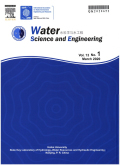Evaluation of alum-based water treatment residuals used to adsorb reactive phosphorus
基本信息来源于合作网站,原文需代理用户跳转至来源网站获取
摘要:
Excess reactive phosphorus (PO4) in waterways can lead to eutrophication. A low-cost approach to reducing PO4 levels in surface water was evaluated using the alum-based water treatment residual (Al-WTR) or Al-WTR augmented with powdered activated carbon (PAC-WTR). Batch adsorption-desorption and continuous flow column experiments were performed to assess the specific adsorption capacities under various concentration and flow conditions. Both Al-WTR and PAC-WTR exhibited the ability to adsorb PO4. The overall, cumulative sorbed amount after a 28-d desorption step for Al-WTR was 33.93 mg/kg, significantly greater than the PAC-WTR value of 24.95 mg/kg ( p < 0.05). The continuous flow column experiments showed a theoretical PO4 uptake of 9.00 mg/g for Al-WTR and 7.14 mg/g for PAC-WTR over 720 h. When surface water was used, the Al-WTR and PAC-WTR columns removed 67.4%and 62.1%of the PO4, respectively. These results indicated that Al-WTR was more effective for in-field evaluation.

推荐文章
Evaluation of groundwater quality in the Dibdibba aquifer using hydrogeochemical and isotope techniq
Safwan-Zubair
Dibdibba formation
Geochemical modeling
Mixing
Stable isotopes
Basra
Groundwater quality assessment using multivariate analysis, geostatistical modeling, and water quali
Groundwater
Multivariate analysis
Geostatistical modeling
Geochemical modeling
Mineralization
Ordinary Kriging
The influence of urbanization on karst rivers based on nutrient concentration and nitrate dual isoto
Urbanization
Urban river
Nitrate isotopes
Southwestern China
Chengguan River
An experimental study of interaction between pure water and alkaline feldspar at high temperatures a
Alkaline feldspar
Autoclave
High-temperature and high-pressure experiments
内容分析
关键词云
关键词热度
相关文献总数
(/次)
(/年)
引文网络
引文网络
二级参考文献 (24)
共引文献 (1)
参考文献 (23)
节点文献
引证文献 (0)
同被引文献 (0)
二级引证文献 (0)
1900(3)
- 参考文献(1)
- 二级参考文献(2)
1984(1)
- 参考文献(0)
- 二级参考文献(1)
1997(1)
- 参考文献(1)
- 二级参考文献(0)
2000(2)
- 参考文献(1)
- 二级参考文献(1)
2001(3)
- 参考文献(1)
- 二级参考文献(2)
2002(1)
- 参考文献(1)
- 二级参考文献(0)
2003(2)
- 参考文献(1)
- 二级参考文献(1)
2004(1)
- 参考文献(0)
- 二级参考文献(1)
2005(2)
- 参考文献(1)
- 二级参考文献(1)
2006(1)
- 参考文献(0)
- 二级参考文献(1)
2007(8)
- 参考文献(4)
- 二级参考文献(4)
2009(4)
- 参考文献(1)
- 二级参考文献(3)
2010(1)
- 参考文献(1)
- 二级参考文献(0)
2011(5)
- 参考文献(2)
- 二级参考文献(3)
2012(4)
- 参考文献(1)
- 二级参考文献(3)
2013(2)
- 参考文献(1)
- 二级参考文献(1)
2014(1)
- 参考文献(1)
- 二级参考文献(0)
2015(3)
- 参考文献(3)
- 二级参考文献(0)
2016(1)
- 参考文献(1)
- 二级参考文献(0)
2017(1)
- 参考文献(1)
- 二级参考文献(0)
2020(0)
- 参考文献(0)
- 二级参考文献(0)
- 引证文献(0)
- 二级引证文献(0)
引文网络交叉学科
相关学者/机构
期刊影响力
水科学与水工程
主办单位:
河海大学
出版周期:
季刊
ISSN:
1674-2370
CN:
32-1785/TV
开本:
出版地:
江苏南京西康路1号河海大学
邮发代号:
创刊时间:
语种:
eng
出版文献量(篇)
573
总下载数(次)
0
总被引数(次)
1538
期刊文献
相关文献
推荐文献
- 期刊分类
- 期刊(年)
- 期刊(期)
- 期刊推荐
一般工业技术
交通运输
军事科技
冶金工业
动力工程
化学工业
原子能技术
大学学报
建筑科学
无线电电子学与电信技术
机械与仪表工业
水利工程
环境科学与安全科学
电工技术
石油与天然气工业
矿业工程
自动化技术与计算机技术
航空航天
轻工业与手工业
金属学与金属工艺
水科学与水工程2021
水科学与水工程2020
水科学与水工程2019
水科学与水工程2018
水科学与水工程2017
水科学与水工程2016
水科学与水工程2015
水科学与水工程2014
水科学与水工程2013
水科学与水工程2012
水科学与水工程2011
水科学与水工程2010
水科学与水工程2009
水科学与水工程2008

 免费查重
免费查重










